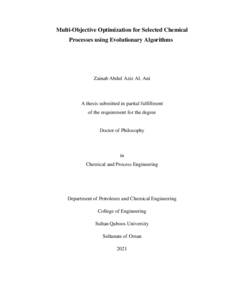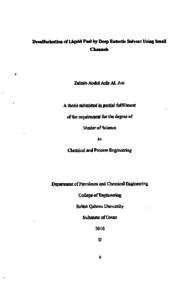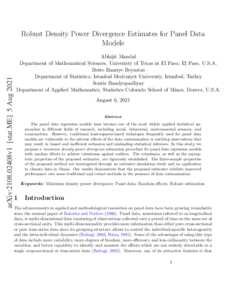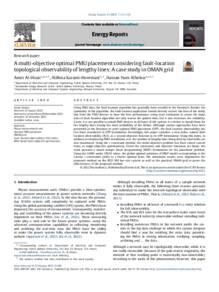وثيقة
Multi-objective optimization for selected chemical processes using evolutionary algorithms.
عناوين أخرى
تحسين بعض العمليات الكيميائية المختارة باستخدام الخوارزميات التطورية
الناشر
Sultan Qaboos University.
ميلادي
2021
اللغة
الأنجليزية
الملخص الإنجليزي
Multi objective optimization (MOO) is a very efficient technique that is used to solve
complex real life problems and it has been employed in different fields. Several algorithms
can be used to carry out MOO problems, but evolutionary algorithms (EA's) like non dominated sorting genetic algorithm-II (NSGA-II) and multi-objective differential
evolution (MODE) proved their successfulness in solving complex problems. Although
these algorithms are efficient, but there is always a potential to improve their speed of
convergence by combining them with a local search method (hybridization). One of the
fields, which EA's were used in, is chemical engineering as they were employed to solve
their complex problems for more than one objective. Processes like lysine fermentation,
sulfuric acid production, acid gas sweetening and natural gas dehydration are some of the
chemical processes that can be improved with MOO from several aspects (economic,
environmental, operation, safety and thermodynamic). In this work, a new hybridization
technique is proposed to improve the performance of MODE algorithm in terms of speed
and convergence. The proposed hybrid MODE-Dynamic Local Search (HMODE-DLS)
is evaluated and validated by solving benchmark test problems (both constrained and non constrained) using MODE and HMODE-DLS. To compare between the two algorithms,
five performance metrics are calculated, which are convergence (Conv), spread (SP),
generational distance (GD), spacing (SPC) and hypervolume ratio (HVR). Mean and
standard deviation (std) values for the performance metrics are reported and the best in
each category is highlighted. The Conv metric results of the new hybrid MODE is
compared with other reported ones. Additionally, the effect of local search probability is
studied for selected problems. In general, HMODE-DLS performance outshines, in terms
of convergence and robustness, compared to other tested algorithms. HMODE-DLS is,
generally, faster and its results are of improved quality compared to MODE algorithm.
NSGA-II is used to solve different MOO cases in industrial lysine bioreactor, sulfuric
acid production, acid gas sweetening and dehydration. The covered objectives are
economical (like profit, production cost, etc), safety (damage index), environmental (like
acid gas and carbon dioxide emissions, etc.), thermodynamic (exergy destruction) and
operational (like yield, productivity, water content, etc.). From each process, two cases
are selected to be solved with another three algorithms (including HMODE-DLS). Gas
dehydrating process was not considered for MOO previously, while the acid gas
sweetening and sulfuric acid production processes are solved in this work with respect to
various new objectives those were not considered in earlier studies. On the other hand,
industrial lysine bioreactor is revisited in this work looking for a better results using the
newly developed algorithm (HMODE-DLS).
A real plant dehydration process is considered for retrofitting and MOO. The
optimization is conducted for the original and the retrofitted processes. The studied MOO
cases are two and three objective problems. Results showed that in each case, specific
decision variables affect the results and cause the conflict between the objectives. The
main decision variable, which is affected by the retrofitting is the temperature of the
reboiler as it converged to values higher than 464.15 K in the original process
configuration. However, in the retrofitted configuration, this value is reduced to 440.38
K. HMODE-DLS, which is used to solve some cases in the process, showed its
effectiveness as it converged to the desired Pareto front. The three objective case studies
solved offered an improvement (with respect to the third objective) compared to the two
objective cases, which make their results more practical to be implemented in the industry.
An acid gas removal process that utilizes dimethyl ethers of polyethylene glycol (DEPG)
as a solvent is simulated with ProMax V4.0 to carry out MOO study with, mainly, NSGA II. The considered objectives are environmental, economic, safety, process and
thermodynamic-based. Several two and three objective cases were conducted and
compared. Removing sulfur can be improved with low temperature and high pressure
operating conditions. Increasing the flow of the gas increases the profit, but it adversely
influences safety and environmental objectives. Increasing the rate of sulfur removal
involves consuming lots of energy, which in turn increases the operating cost and reduces
the profit. Exergy destruction high values are encountered when high sulfur removal,
methane recovery or profits are needed. When HMODE-DLS is used to solve some cases
with other algorithms, it was able to achieve the needed Pareto front.
Two MOO cases in an industrial lysine bioreactor at different feeding conditions are
solved. Case 1 considers maximizing lysine's productivity and yield. While case 2 studies
the maximization of productivity along with minimization of total operating time. In all
cases, theoretical and industrial, HMODE-DLS showed a better performance with a better
quality Pareto set of solutions. The Pareto front of case 1 found by HMODE-DLS is
compared with a recent study trade-off, and the current non-dominated solutions values
are found to be improved. For case 2, the switching time from fed-batch to batch is found
to be the key decision variable.
A sulfuric acid production plant that is simulated with Aspen Plus is considered for MOO
using EMOO with NSGA-II. Several objectives are taken into consideration like profit,
GWP, acidic emissions, I, etc. Results showed that air flow rate and production amount
are the key decision variables those are causing the conflict between the objectives. It can
be said that there is a potential for improving such sulfuric acid process and the results are
useful to bring a deeper understanding. Similar to previous process, HMODE-DLS results
are comparable to MODE results as they are able to achieve the desired Pareto, which is
not the case with I-MODE, improved MODE, and NSGA-II.
المجموعة
URL المصدر
الملخص العربي
التحسين متعدد الأهداف هو تقنية عالية الكفاءة يتم استخدامها لحل المشاكل الحياتية المعقدة في مختلف المجالأت.
من الممكن استخدام العديد من الخوارزميات لعمل هذا التحسين ولكن خوارزميات التطور مثل II-NSGA و
MODEأثبتا نجاحهما. على الرغم من نجاعة هذه الخوارزميات، الأ أنه يوجد دائما فرصة لتحسين سرعتهم عن
طريق دمجهم مع طرق بحث محلية (التهجين) . أحد المجالأت التي تم استخدام خوارزميات التطور فيها هو مجال
الهندسة الكيميائية، حيث تم استخدامهم للتحسين متعدد الأهداف. من الممكن تحسين عمليات مثل تخمير الاليسين،
إنتاج حمض الكبريتيك وعمليات معالجة الغاز الطبيعي ألهداف متعددة ومن نواح مختلفة (اقتصادية، بيئية، عملية،
السالمة والديناميكية الحرارية).
في هذا العمل، تم تطوير تقنية جديدة تهجين خوارزمية MODE لتحسين سرعتها. تم اختبار كفاءة خوارزمية
(DLS-HMODE (Search Local Dynamic-MODE الناتجة من التهجين عن طريق حل العديد من المشاكل
متعددة الأهداف المتعارف عليها باستخدام MODE و-HMODE (Search Local Dynamic-MODE
(DLS. لمقارنة الخوارزميتين، تم الأستعانة بخمس مقاييس لألداء هي ,(SP (spread ,)Conv (convergence
المتوسط حساب تم .generational distance (GD), spacing (SPC) and hypervolume ratio (HVR)
والأنحراف المعياري لهذه المقاييس وتحديد الخوارزمية الأفضل. نتائج مقياس Conv ل DLS-HMODE تم
مقارنتها مع عدد من الخوارزميات. بالأضافة لذلك، تم دراسة تأثير عامل البحث المحلي لمسائل مختارة. في العموم،
وجد ان DL-HMODE يتفوق على بقية الخوارزميات. حيث أن DLS-HMODE أسرع اداءا و ذو نتائج أفضل
مقارنة بخوارزمية MODE.
تم استخدام II-NSGA لحل المشاكل المتعددة الأهداف المختلفة في العمليات الصناعية كتخمير الاليسين، إنتاج
حمض الكبريتيك وعمليات معالجة الغاز الطبيعي (عمليتي إزالة المياه والغازات الحمضية). العديد من الأهداف تم
التركيز عليها كالأهداف الأقتصادية (الربح، تكلفة الأنتاج، إلخ)، والسالمة، والأهداف البيئية (تقليل انبعاثات الغازات
الضارة بالبيئة) وأهداف متعلقة بالديناميكية الحرارية، إضافة إلى الأهداف المتعلقة بالعملية ذاتها (الأنتاجية، العائد،
مقدار المياه في الغاز، إلخ). تم اختيار حالتين من كل عملية ليتم حلهم باستخدام خوارزميات أخرى بمن فيهم
DLS-HMODE. لم يتم مسبقا عمل دراسة لحل المشكال متعددة الأهداف لعملية إزالة الماء من الغاز الطبيعي. أما
بالنسبة للعمليات الكيميائية الأخرى, فقد تمت دراستها ألهداف جديدة لم يتم التطرق لها في أي دراسة سابقة.
تم اختيار عملية صناعية متواجدة في سلطنة عمان إلزالة المياه من الغاز الطبيعي لتحسينها من العديد من النواحي
إضافة الى تعديلها بإضافة وحدة الى الوحدات المتواجدة في الأساس. الحالات التي تمت دراستها ثنائية وثالثية الأهداف.
أظهرت النتائج وجود عوامل معينة تؤثر عليها وتسبب التضارب بين الأهداف. العامل الرئيسي الذي تسبب في اختالف
النتائج بين العملية الأساسية والعملية المعدلة هو درجة حرارة المرجل حيث ان نتائج هذا العامل كانت اعلى
من K 464.15 في العملية الأساسية وانخفض إلى K 440.38 في العملية المعدلة. أثبتت الخوارزمية المهجنة المقدمة
في هذا العمل كفاءتها في حل حالتين من الحالات التي تم أخذها بعين الأعتبار لهذه العملية الصناعية. الحالات ثالثية
الأهداف وفرت المزيد من التحسين مقارنة بالحالات ثنائية الأهداف، حيث ان نتائج الحالات الثلاثية من الممكن تطبيقها
على ارض الواقع.عملية إزالة الغازات الحمضية من الغاز الطبيعي تم دراستها لعملية تستخدم of ethers dimethyl
glycol polyethylene) DEPG (كمذيب. تم محاكاة هذه العملية باستخدام 4.0V ProMax وتحسينها ألهداف
متعددة باستخدام خوارزمية II-NSGA. في هذا العملية أيضا تم أخذ العديد من الأهداف المختلفة بعين الأعتبار وحل
العديد من الحالات ثنائية وثالثية الأهداف. وجد أمن من الممكن تحسين إزالة الكبريت عند درجات حرارة منخفضة
وضغط مرتفع. زيادة سريان الغاز يعمل على زيادة الربح ولكن ذلك يؤثر سلبا على الأهداف المتعلقة بالسالمة والبيئة.
إزالة كميات أكبر من الكبريت تتضمن استخدام مقدار عال من الطاقة، والذي بدوره يعمل على زيادة تكلفة الأنتاج
ويقلل من الربح. تتأثر الديناميكية الحرارية للعملية وترتفع عند ارتفاع كمية الكبريت المزالة، كمية الميثان المسترجعة
وارتفاع الربح. في هذه العملية أيضا، اثبتت خوارزمية DLS-HMODE نجاعتها وقدرتها على حل الحالات
المختارة.
تم حل حالتين ثنائيتي الأهداف لعملية تخمير الاليسين داخل مفاعل حيوي في ظروف مختلفة. في الحالة الأولى تم
العمل على زيادة العائد والأنتاجية بينما في الحالة الثانية تم العمل على زيادة الأنتاجية وتقليل المدة التي تستغرقها
العملية. في كل الحالات المدروسة، وجد ان DLS-HMODE قادر على الوصول إلى نتائج أفضل مقارنة بباقي
الخوارزميات المستخدمة. تم مقارنة نتائجDLS-HMODE للحالة الأولى بتلك التي تم إيجادها مؤخرا وثبت أن
النتائج الحالية أفضل من سابقتها. بالنسبة للحالة الثانية، وجد ان الوقت المستغرق للتحويل من batch-fed إلى batch
هو العامل الأساسي المؤثر.
عملية إنتاج حمض الكبريتيك تم محاكاتها باستخدام Plus Aspen وتحسينها للعديد من الأهداف. أظهرت النتائج
أن مقدار سريان الهواء وكمية الأنتاج هما العاملين الأكثر تأثيرا في هذه العملية. ومن الممكن القول إنه يوجد احتمالية
جيدة لتحسين هذا النوع من العمليات واستخدام النتائج لتوفير فهم أعمق. في هذه العملية أيضا اثبت DLS-HMODE
قدرته على حل المشاكل المعقدة والوصول إلى النتائج المطلوبة، وهو ما لم يحدث مع MODE-IوII-NSGA.
من الممكن استخدام العديد من الخوارزميات لعمل هذا التحسين ولكن خوارزميات التطور مثل II-NSGA و
MODEأثبتا نجاحهما. على الرغم من نجاعة هذه الخوارزميات، الأ أنه يوجد دائما فرصة لتحسين سرعتهم عن
طريق دمجهم مع طرق بحث محلية (التهجين) . أحد المجالأت التي تم استخدام خوارزميات التطور فيها هو مجال
الهندسة الكيميائية، حيث تم استخدامهم للتحسين متعدد الأهداف. من الممكن تحسين عمليات مثل تخمير الاليسين،
إنتاج حمض الكبريتيك وعمليات معالجة الغاز الطبيعي ألهداف متعددة ومن نواح مختلفة (اقتصادية، بيئية، عملية،
السالمة والديناميكية الحرارية).
في هذا العمل، تم تطوير تقنية جديدة تهجين خوارزمية MODE لتحسين سرعتها. تم اختبار كفاءة خوارزمية
(DLS-HMODE (Search Local Dynamic-MODE الناتجة من التهجين عن طريق حل العديد من المشاكل
متعددة الأهداف المتعارف عليها باستخدام MODE و-HMODE (Search Local Dynamic-MODE
(DLS. لمقارنة الخوارزميتين، تم الأستعانة بخمس مقاييس لألداء هي ,(SP (spread ,)Conv (convergence
المتوسط حساب تم .generational distance (GD), spacing (SPC) and hypervolume ratio (HVR)
والأنحراف المعياري لهذه المقاييس وتحديد الخوارزمية الأفضل. نتائج مقياس Conv ل DLS-HMODE تم
مقارنتها مع عدد من الخوارزميات. بالأضافة لذلك، تم دراسة تأثير عامل البحث المحلي لمسائل مختارة. في العموم،
وجد ان DL-HMODE يتفوق على بقية الخوارزميات. حيث أن DLS-HMODE أسرع اداءا و ذو نتائج أفضل
مقارنة بخوارزمية MODE.
تم استخدام II-NSGA لحل المشاكل المتعددة الأهداف المختلفة في العمليات الصناعية كتخمير الاليسين، إنتاج
حمض الكبريتيك وعمليات معالجة الغاز الطبيعي (عمليتي إزالة المياه والغازات الحمضية). العديد من الأهداف تم
التركيز عليها كالأهداف الأقتصادية (الربح، تكلفة الأنتاج، إلخ)، والسالمة، والأهداف البيئية (تقليل انبعاثات الغازات
الضارة بالبيئة) وأهداف متعلقة بالديناميكية الحرارية، إضافة إلى الأهداف المتعلقة بالعملية ذاتها (الأنتاجية، العائد،
مقدار المياه في الغاز، إلخ). تم اختيار حالتين من كل عملية ليتم حلهم باستخدام خوارزميات أخرى بمن فيهم
DLS-HMODE. لم يتم مسبقا عمل دراسة لحل المشكال متعددة الأهداف لعملية إزالة الماء من الغاز الطبيعي. أما
بالنسبة للعمليات الكيميائية الأخرى, فقد تمت دراستها ألهداف جديدة لم يتم التطرق لها في أي دراسة سابقة.
تم اختيار عملية صناعية متواجدة في سلطنة عمان إلزالة المياه من الغاز الطبيعي لتحسينها من العديد من النواحي
إضافة الى تعديلها بإضافة وحدة الى الوحدات المتواجدة في الأساس. الحالات التي تمت دراستها ثنائية وثالثية الأهداف.
أظهرت النتائج وجود عوامل معينة تؤثر عليها وتسبب التضارب بين الأهداف. العامل الرئيسي الذي تسبب في اختالف
النتائج بين العملية الأساسية والعملية المعدلة هو درجة حرارة المرجل حيث ان نتائج هذا العامل كانت اعلى
من K 464.15 في العملية الأساسية وانخفض إلى K 440.38 في العملية المعدلة. أثبتت الخوارزمية المهجنة المقدمة
في هذا العمل كفاءتها في حل حالتين من الحالات التي تم أخذها بعين الأعتبار لهذه العملية الصناعية. الحالات ثالثية
الأهداف وفرت المزيد من التحسين مقارنة بالحالات ثنائية الأهداف، حيث ان نتائج الحالات الثلاثية من الممكن تطبيقها
على ارض الواقع.عملية إزالة الغازات الحمضية من الغاز الطبيعي تم دراستها لعملية تستخدم of ethers dimethyl
glycol polyethylene) DEPG (كمذيب. تم محاكاة هذه العملية باستخدام 4.0V ProMax وتحسينها ألهداف
متعددة باستخدام خوارزمية II-NSGA. في هذا العملية أيضا تم أخذ العديد من الأهداف المختلفة بعين الأعتبار وحل
العديد من الحالات ثنائية وثالثية الأهداف. وجد أمن من الممكن تحسين إزالة الكبريت عند درجات حرارة منخفضة
وضغط مرتفع. زيادة سريان الغاز يعمل على زيادة الربح ولكن ذلك يؤثر سلبا على الأهداف المتعلقة بالسالمة والبيئة.
إزالة كميات أكبر من الكبريت تتضمن استخدام مقدار عال من الطاقة، والذي بدوره يعمل على زيادة تكلفة الأنتاج
ويقلل من الربح. تتأثر الديناميكية الحرارية للعملية وترتفع عند ارتفاع كمية الكبريت المزالة، كمية الميثان المسترجعة
وارتفاع الربح. في هذه العملية أيضا، اثبتت خوارزمية DLS-HMODE نجاعتها وقدرتها على حل الحالات
المختارة.
تم حل حالتين ثنائيتي الأهداف لعملية تخمير الاليسين داخل مفاعل حيوي في ظروف مختلفة. في الحالة الأولى تم
العمل على زيادة العائد والأنتاجية بينما في الحالة الثانية تم العمل على زيادة الأنتاجية وتقليل المدة التي تستغرقها
العملية. في كل الحالات المدروسة، وجد ان DLS-HMODE قادر على الوصول إلى نتائج أفضل مقارنة بباقي
الخوارزميات المستخدمة. تم مقارنة نتائجDLS-HMODE للحالة الأولى بتلك التي تم إيجادها مؤخرا وثبت أن
النتائج الحالية أفضل من سابقتها. بالنسبة للحالة الثانية، وجد ان الوقت المستغرق للتحويل من batch-fed إلى batch
هو العامل الأساسي المؤثر.
عملية إنتاج حمض الكبريتيك تم محاكاتها باستخدام Plus Aspen وتحسينها للعديد من الأهداف. أظهرت النتائج
أن مقدار سريان الهواء وكمية الأنتاج هما العاملين الأكثر تأثيرا في هذه العملية. ومن الممكن القول إنه يوجد احتمالية
جيدة لتحسين هذا النوع من العمليات واستخدام النتائج لتوفير فهم أعمق. في هذه العملية أيضا اثبت DLS-HMODE
قدرته على حل المشاكل المعقدة والوصول إلى النتائج المطلوبة، وهو ما لم يحدث مع MODE-IوII-NSGA.
قالب العنصر
الرسائل والأطروحات الجامعية




